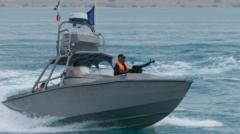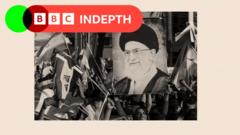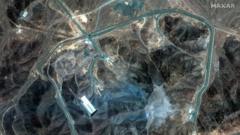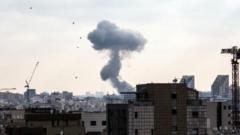The United States launched a complex air operation dubbed "Operation Midnight Hammer," employing decoy flights and B-2 stealth bombers to target Iran's fortified nuclear facilities, resulting in claims of significant damage to the nuclear program.
U.S. Conducts Covert Airstrikes on Iranian Nuclear Facilities: Operation Midnight Hammer

U.S. Conducts Covert Airstrikes on Iranian Nuclear Facilities: Operation Midnight Hammer
A detailed account of the United States' recent military operation, featuring strategic deception and precision bombing against Iran’s nuclear sites.
In a dramatic military operation termed "Operation Midnight Hammer," the United States has successfully targeted Iran's nuclear facilities utilizing advanced tactics and weaponry. According to General Dan Caine, the Chairman of the Joint Chiefs of Staff, this high-stakes mission featured a well-coordinated series of airstrikes that began shortly after midnight.
Mission specifics revealed by the Pentagon indicate that the operation involved the deployment of seven B-2 stealth bombers, which took off from Whiteman Air Force Base in Missouri under the cover of darkness. These planes were armed with specialized "bunker buster" bombs, designed to penetrate deeply buried structures like the Fordo nuclear enrichment facility, a key site in Iran's nuclear ambitions.
To mislead potential observers, U.S. officials initiated a sequence of decoy flights towards Guam, diverting attention from the real operation taking place over the Atlantic Ocean. General Caine emphasized the tight control over communications and the degree of secrecy maintained throughout the mission. The B-2s traveled undetected, further aided by aerial support that neutralized any potential Iranian threats.
Intelligence suggests that the U.S. experience in the region, bolstered by Israeli air dominance, contributed to the operation's success. During the assault, Tomahawk land-attack cruise missiles were simultaneously launched from a U.S. submarine, coordinating strikes on multiple targets. This method ensured that significant Iranian nuclear infrastructures were attacked in a synchronized manner.
The Pentagon reported that the strikes began at approximately 18:40 EDT, targeting Fordo and another major site at Natanz, using massive ordnance penetrators capable of reaching impressive depths. The operation saw the use of around 75 precision-guided munition, with claims of destructive effectiveness touted by U.S. officials.
While initial assessments from U.S. defense experts celebrate the tactical success of Operation Midnight Hammer, the true extent of damage remains to be confirmed as satellite imagery and further evaluations are underway. Iran has acknowledged the strikes, albeit downplaying the damage inflicted, leaving the international community to gauge the operation's long-term implications for nuclear proliferation in the region.
As the dust settles on this high-stakes military engagement, analysts remain cautious about the potential for escalating tensions and the broader ramifications for U.S.-Iran relations moving forward.





















